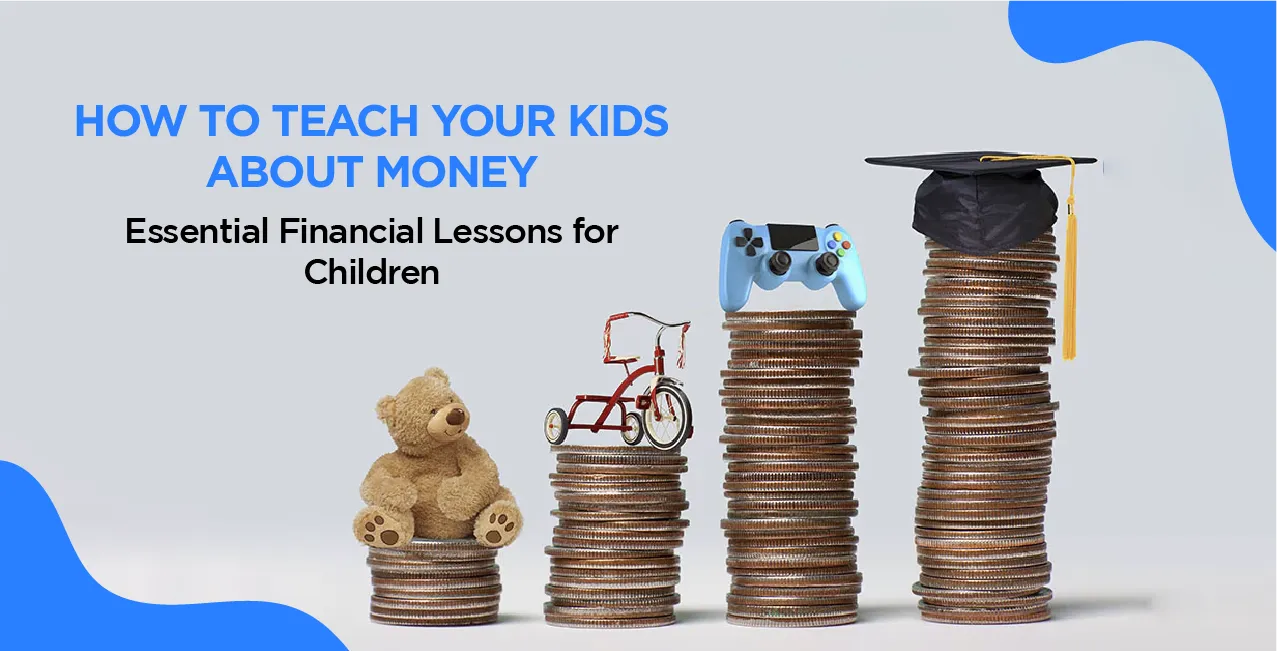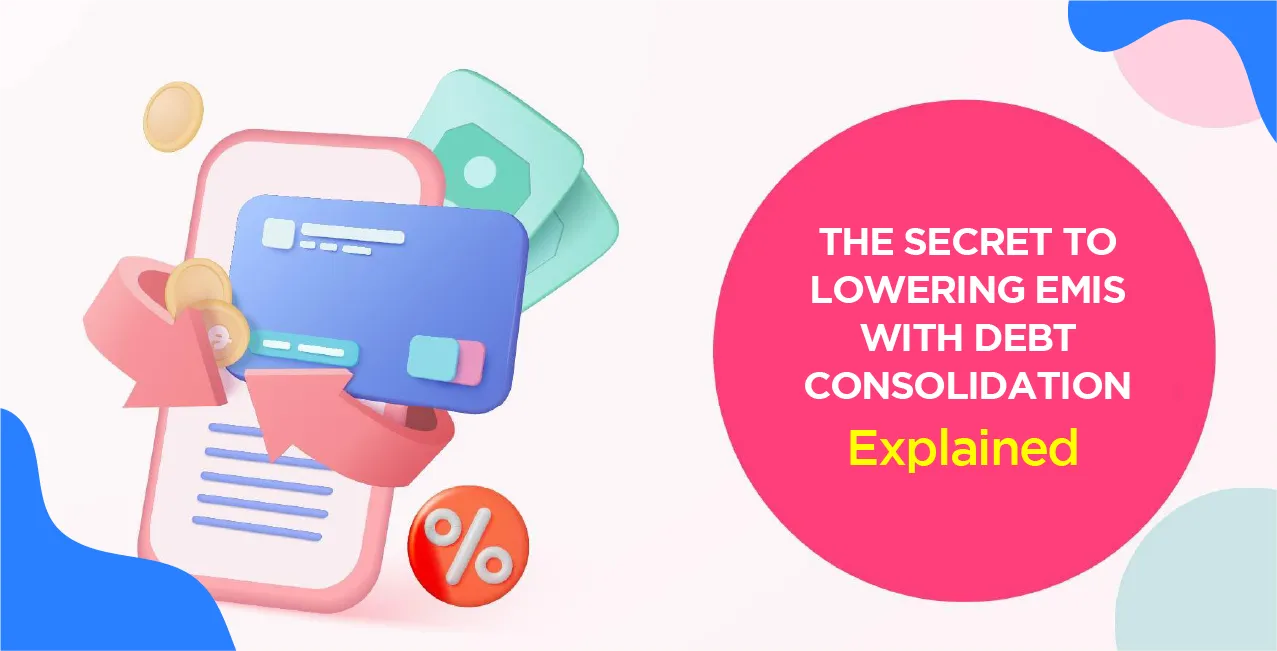
Author
LoansJagat Team
Read Time
10 Min
06 May 2025
How to Teach Your Kids About Money – Essential Financial Lessons for Children
Tara is 11. Lives in Pune. Loves telling stories. Every Sunday at her nani’s house, she gathers her little cousins and charges them ₹10 per story under the mango tree. Last month, she made ₹160 just like that—no startup, no Shark Tank pitch, just good old storytelling.
Her mom, Asha, noticed something cool—Tara wasn’t just spending that money on junk. She used her dad’s old phone to track it in a simple notes app and split it into three parts:
- ₹60 to spend on toffees and sketch pens
- ₹80 to save for a Kindle (she’s eyeing one that costs ₹7,000)
- ₹20 she donated to a nearby dog shelter
When Asha asked why she was doing this, Tara said, “Every ₹10 note has a story. I’m just collecting mine.”
No lectures. No financial planner. Just a kid picking up money smarts from real life—and that’s honestly where it all begins.
Bachpan Se Billionaire Mindset—Start Early, Start Right
Financial literacy starts young. According to, money habits are formed by age 7, so why wait? Start educating your children on basic things such as saving, sharing, and spending at a young age.
For example, Tara was saving pocket money by the time she was 5 years old. For every ₹20 she received, she divided it into three parts: ₹10 to be saved, ₹5 for a treat, and ₹5 for a donation.
Asha had made it a habit of including Tara in her daily activities, such as grocery shopping. On one occasion, Tara was deciding between a snack that was ₹40 and a snack that was ₹50. Tara said, “I’ll get the ₹40 one ₹10 adds up!”
Tip: Use grocery shopping to help children learn about prices, totals, and choices. It's easy to start developing money habits like these.
Read More - Teaching Financial Literacy: Money Lessons for the Next Generation Costs
Piggy Bank 2.0—Make Pocket Money Digital
Physical piggy banks are cute, but digital wallets are the new normal. Apps like Fyp, Junio, and Akudo are gaining popularity with Gen Alpha, offering a gamified, safe, and educational way to manage money.
For example, Asha switched Tara’s allowance to a digital wallet, assigning ₹200 per week, with ₹50 set aside for savings. By the end of the month, Tara had saved ₹200 without even realising it.
Monthly Allowance | Savings per Month | Total Savings by Year-End |
₹800 | ₹200 | ₹2,400 |
By making pocket money digital, Tara learnt the value of saving while having fun. A small weekly allowance can add up quickly when managed through apps, making it easy for kids to track, save, and even set goals—all while staying engaged.
Ghar Ki Kirana, Finance Ka Gyaan—Involve Them in Home Budgeting
Turn routine tasks like grocery shopping and bill payments into real-time finance lessons. Asha made sure Tara was involved in household budgeting, teaching her how to manage expenses like a pro.
This is how they did it:
Distribution of Money for Groceries, Electricity, and Wi-Fi:
Asha allotted a monthly limit of ₹10,000 for home expenses altogether. They divided it into:
- ₹5,000 for groceries
- ₹2,000 for electricity
- ₹1,000 for Wi-Fi
- ₹2,000 for miscellaneous bills
Reading the Electricity Meter:
A month later, Asha asked Tara to estimate the electricity bill by reading the meter.
- The meter read 1,200 units consumed.
- Tara rapidly calculated the bill:
- 1,200 units × ₹7/unit = ₹8,400.
The actual bill was ₹8,500, only ₹100 higher than Tara's estimate!
Tracking Monthly Expenses Using Google Sheets:
Tara used to help Asha monitor the spending every week using Google Sheets, updating the figures and ensuring they didn't go over budget. For instance, by the end of the first week, they had spent
- ₹1,200 on food
- ₹500 on electricity
- ₹300 on Wi-Fi
At the end of the month, Tara could identify where the family's money was going and how they could make the next month's budget more efficient.
Chhoti Umar, Badi Soch—Teach Goal-Based Savings
Teaching Tara goal-based savings keeps her motivated and helps her understand the importance of planning for the future. By setting both short-term and long-term goals, Asha showed Tara how saving can turn dreams into reality.
This is how they did it:
Goal | Amount Needed | Savings per Week/Month | Timeframe | Total Saved by Target Date |
Unicorn Soft Toy (Short-Term) | ₹500 | ₹125 (per week) | 4 weeks | ₹125 × 4 weeks = ₹500 |
Kindle (Long-Term) | ₹7,000 | ₹1,167 (per month) | 6 months | ₹1,167 × 6 months = ₹7,002 |
Use visual trackers or apps like Goalwise Junior to make goal-based savings fun and motivating for your children.
Ye Paisa Kya Kehlata Hai? —Use Games and Stories to Explain Money
Money doesn’t have to be boring! Asha turned learning about money into a fun experience for Tara by using games, stories, and interactive apps.
This is how they did it:
Board Games:
- Asha introduced Tara to Monopoly, where they had to manage properties, pay rent, and save money. It helped Tara understand the concept of budgeting and decision-making.
- For example, Tara bought a house for ₹2,000 and had to pay ₹500 rent every time someone landed on her property. By the end of the game, she saw how saving and spending wisely affected her total wealth.
Stories:
- Asha told Tara the story of Dadi, who bought her first home by saving ₹500 a month.
- "Dadi didn’t have a lot of money, but she saved ₹500 every month for 5 years. By the end of 5 years, she had saved ₹30,000 to buy her first house!"
Apps:
- Tara loved using Khan Academy Kids and Kiddopia, which offered interactive finance lessons. In one of the app challenges, Tara had to save ₹50 to buy a virtual pet.
- Every time she saved ₹50 in the app, she unlocked a new pet, teaching her the value of setting small savings goals.
Needs vs Wants—Kya Zaroori Hai, Kya Fancy Hai?
It was a typical Sunday shopping trip when Tara spotted a glittery, sparkly diary at the billing counter.
"Mumma, can I purchase this? It's so pretty!" she asked, her eyes wide with excitement.
Asha smiled and sat down beside her, eyeing the diary with a smile. "Okay, let's play our little game—Need or Want?"
Tara hesitated. "Hmm… I already have two diaries at home."
"Right! Is it a zaroori need or a fancy want?" Asha asked.
"A fancy want," Tara sighed.
"Good call!" Asha high-fived her. "Now, let's ask the 3 magical questions:
- Do I really need it?
- Can I afford it right now?
- Will I use it after 30 days?"
Together, they ended up buying toothpaste (a clear need) and skipping the diary. But Asha noted it on Tara’s “wishlist”, something they’d revisit next month if she still wanted it.
Lesson Unlocked: Differentiating between zaroori and lalach wala purchases builds mindful spending habits. Tara may not have bought the diary, but she walked out feeling like a budgeting boss.
EMI Ka ABCD—Simplifying Loans and Interest Early On
Loans and EMIs might sound like “grown-up talk”, but it’s never too early to teach your kids that borrowing money comes at a cost.
For example, when Tara asked Asha if they could buy a new ₹50,000 phone on EMI, Asha used the moment to explain how interest works.
She broke it down like this:
“When you borrow money, you pay it back with extra paisa—that’s called interest. And EMI means you’re paying that total in small monthly chunks.”
Here’s how Asha showed Tara the real cost:
Loan Amount | Tenure | Interest Rate | Monthly EMI | Total Paid | Extra Interest |
₹50,000 | 12 months | 12% p.a. | ₹4,446 | ₹53,352 | ₹3,352 |
Tara’s takeaway?
“EMI = Easy Monthly Installments, but also Extra Money Included!”
Also Read - Best Savings Strategies for New Parents
Doston Ke Saath, Paisa Safe—How to Handle Peer Pressure
Tara’s Diary — Entry #17
Dear Diary,
Today, Meher came to school flashing her brand-new iPhone 16 Mini. Everyone crowded around her like she was some celeb! For a moment, I felt weird. My phone suddenly looked... ancient.
At lunch, I told Mumma about it. She didn’t say no or yes. She just asked, “Are you unhappy with your phone or just feeling left out?”
Honestly? I didn’t need a new phone. I just didn’t want to feel left behind.
Then she reminded me—my Kindle goal is just ₹2,000 away! That got me pumped again. iPhone can wait.
Kindle = reading anytime, anywhere, and escaping into new worlds!
The Lesson Of The Day: Not everything your friends buy needs to be on your wishlist. My pace, my goals.
Neki Kar, SIP Shuru Kar—Introduce Investments Smartly
Asha sat down with Tara and showed her the magic of investing early. “You don’t have to wait until you’re 18 to start building wealth,” Asha explained. “The earlier you start, the better.”
She introduced Tara to the concept of SIPs (Systematic Investment Plans) and how they allow you to invest a fixed amount
monthly in mutual funds. Tara was fascinated! Asha explained the difference between saving (keeping money safe) and investing (making money grow).
They then created a demo SIP portfolio with a ₹500/month contribution and an expected 12% annual return.
Here’s how it looked after 10 years:
Monthly SIP | Expected Return | Tenure | Total Investment | Total Value after 10 Years | Profit |
₹500 | 12% p.a. | 10 years | ₹60,000 | ₹1,01,228 | ₹41,228 |
Tara was amazed. “So, if I keep doing this every month, I could have ₹1,00,000 by the time I’m 15?”
Asha nodded, “Exactly! Start early, and your money works for you.”
Mini Lesson:
Small monthly investments add up over time, just like compound interest magic!
Paisa Aaya, Paisa Gaya?—Make Them Track Their Spending
Asha sat Tara down in the kitchen with a notebook and a pencil.
“Okay, Tara. We need to track your spending,” Asha said. “It’s like keeping a record of your treasure hunts—you need to know where you’re spending and where you’re saving.”
Tara frowned. “But I don’t spend much, Mumma.”
Asha smiled, “Even small expenses add up! So, here’s how we do it.”
Step 1: Track Daily/Weekly Spends
“Write down everything you spend money on. You can use a notebook or a Google Sheet. For example, you bought that unicorn soft toy last week for ₹500—write that down.”
Step 2: Categorise Your Spending
“Divide your expenses into categories. Like food, entertainment, gifts, etc. You can use apps like Walnut or FamPay to do this automatically!”
Step 3: Review and Reflect
“Now, every week, we’ll look at how much you’ve spent. Is there something you could’ve skipped? Maybe the extra ₹100 on ice cream could’ve gone into your Kindle savings fund?”
Moral of the Story? The more mindful you are, the easier it gets to identify areas to cut back and save more.
The Debt Trap Talk—What Every Teen Must Know
One evening, Asha and Tara sat down to talk about the dangers of debt. Asha wanted Tara to understand the difference between good debt and bad debt. She also explained the importance of paying bills on time to maintain a good CIBIL score.
Asha then gave Tara a real-life example of how late payments could affect her future:
Debt Type | Good Debt | Bad Debt |
Example | Education loan | Credit card debt or BNPL |
Purpose | Investing in the future (education) | Non-essential spending (shopping) |
Impact on CIBIL | Can help build a credit score | Lowers the CIBIL score if unpaid |
Late Payment Impact | May cause delays, but recoverable | High late fees and long-term damage |
Result | Easier loan approvals for big purchases | Difficulty in securing home loans, car loans, etc. |
Final Thoughts
In conclusion, teaching your kids about money in 2025 doesn’t have to be boring or intimidating. By using real-life examples, interactive activities, and simple lessons, you can build their financial literacy from a young age.
Tara’s journey shows that when children are involved in budgeting, saving, and understanding basic financial concepts like loans, investments, and tracking spending, they develop healthy money habits that last a lifetime. From setting goals to learning from mistakes, these small steps lead to big financial wisdom.
Remember, it's not about complex lectures—it's about giving them the tools to make informed, smart choices for their future!
FAQs
- At what age should I start teaching my child about money?
Start as early as 4 to 5 years old. Basic concepts like saving and spending can be introduced through everyday activities.
- What are the best money apps for Indian kids in 2025?
Fyp, Junio, Akudo, Goalwise Junior, and Walnut are great for teaching financial concepts safely.
- How can I make money lessons fun for my child?
Use board games, real-life roleplay, stories, and reward systems to gamify learning.
- How do I explain digital money and UPI to my kid?
Show them how UPI works through live demos. Explain the difference between credit, debit, and digital wallets in simple terms.
About the Author

LoansJagat Team
‘Simplify Finance for Everyone.’ This is the common goal of our team, as we try to explain any topic with relatable examples. From personal to business finance, managing EMIs to becoming debt-free, we do extensive research on each and every parameter, so you don’t have to. Scroll up and have a look at what 15+ years of experience in the BFSI sector looks like.

Quick Apply Loan
Subscribe Now
Related Blog Post


